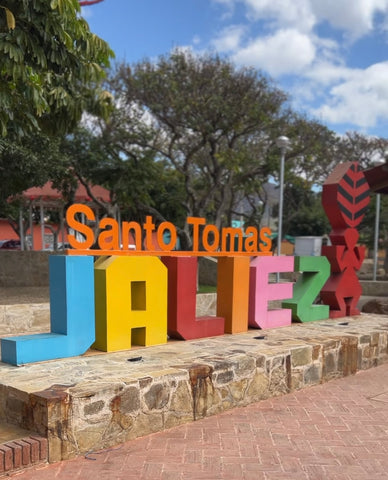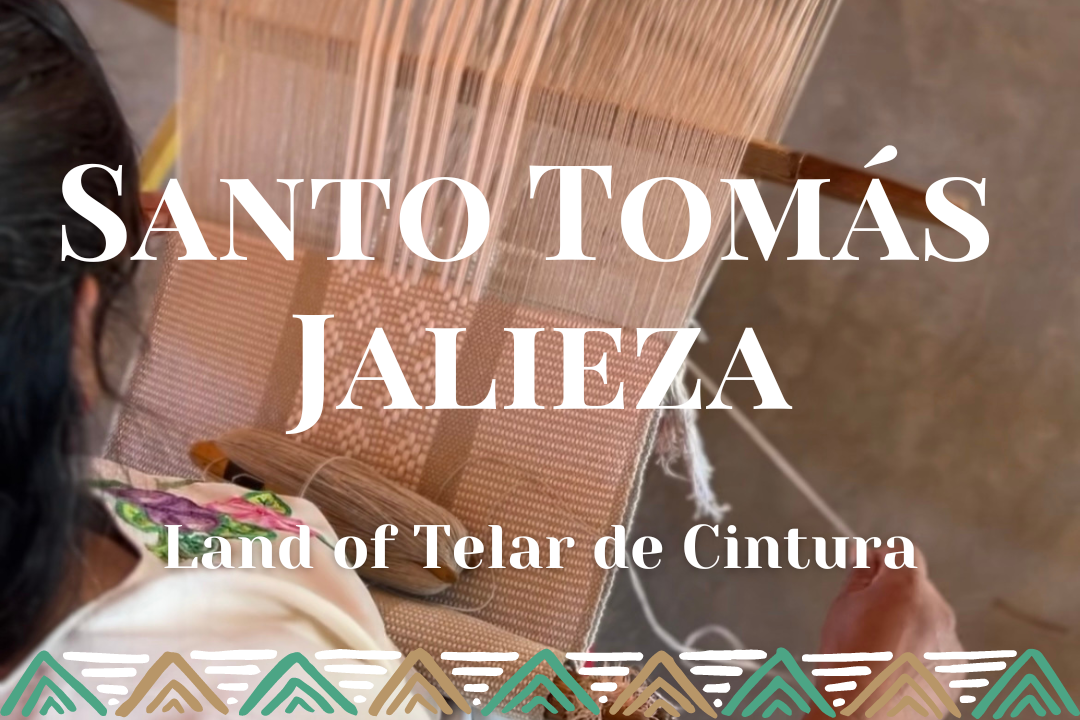Oaxaca is a state with an enormous cultural representation. Crafts vary as we move through the entity's 8 regions. Entering specifically the Central Valleys region, we can find pieces made with barro negro (black clay) such as that of San Bartolo Coyotepec, barro rojo (red clay) from Santa María Atzompa, Alebrijes made in San Martín Tilcajete, or the incomparable embroideries of San Antonino Castillo Velasco.
On this occasion we want to share with you more about Telar de Cintura (backstrap loom weaving), an activity carried out in Santo Tomás Jalieza, and especially highlight the life of Flor, an artisan who, together with her family, preserve this valuable ancestral knowledge.
At the end of January, we had the honor of visiting Santo Tomás Jalieza and the casa-taller of Mrs. Flor and Felipe, collaborators of the spectacular pieces you can find at Lolo.

The Town Below The Church: Santo Tomás Jalieza
Santo Tomás Jalieza is a town located 45 minutes from the center of the City of Oaxaca de Juárez on the way to Ocotlán de Morelos. Arriving at Santo Tomas Jalieza feels like getting into a magical town with well-built roads and avenues in a perfect grid. The colored Church and its imposing wall dominate the town plaza and center. Precisely "Jalieza" means "below the church" in Zapotec.
In this town, artisans use telar de cintura to make various items, while keeping traditions that have been passed down from one generation to the next. In this community, a sense of order, respect, and doing things for the good of the whole is very important. Even the idea of "serving the community" is the most important social value in this ancient way of life that has managed to stay alive.

Before visiting Flor and Felipe casa-taller, we stopped by the local Mercado de Artesanías. In the craft market, a cooperative of artisans sell and make irresistible pieces of an immense variety, all made on backstrap looms. They are highly organized cooperatives that encourage fair prices and just repartition of each sale.
This for us was an impressive sight and something definitely worth spending time at. However, we were also excited to (finally) meeting with Flor, Felipe, and Karina at their house. This is a family of artisans we have worked with since the beginning of Lolo in 2020. Although we constantly communicate through calls and messages, we just had yet to have the opportunity to meet face-to-face.
Between Looms and Memelitas
Although initially a short visit, the welcoming atmosphere and the much-needed catching-up ended up being the rest of our day. We sat at the table and talked for hours with homemade memelitas, laughter, and anecdotes while chickens clucked in the background and a warm wind caressed the looms surrounding us.

As we sat down to catch up, Flor told us her life story: she was raised and educated by parents dedicated to Telar de Cintura as well as trade. Like all the children in the community, Flor was taught the waist loom technique from age 6 by her aunts. She told us that it was easy for her to learn because, in the community, there is a hierarchy that is used to teach this craft: they start by making small, thin pieces to be able to master the technique, and later, the length and width of the loom increase until they manage to master the art. However, Flor tells us that since her parents were also engaged in commerce, her family could only spend a little bit of time making these looms. So, it was until the age of 20, when she began to dedicate her time fully to this.
Flor married Felipe at the age of 20, who, like her, had mastered the technique of telar since he was a child. Together they formed a family of 3 children who, at the time, were also taught to make looms with cotton thread. Therefore each of his children from the age of 7 inherit this great work.
This type of loom, of pre-Hispanic origin, owes its name to the fact that one end is tied to the artisan's waist and another to a tree or wooden post. It is also known as Telar de dos Barras (Two-Bar Loom) or Telar de Otate (Otate Loom), because its structure is made up of two rods of that plant.
Flor explained that the waist loom is a technique that consists of weaving cotton threads using different tools that intertwine each of the threads to create their intrinsic details. We learned that each piece comes from its maker's imagination: they decide the combinations when assembling their loom, as they also decide which design to incorporate.
The first step to weaving is to prepare its warp. For this, they use a small lantern made of wood, called 'muchito', because before it, several decades ago, children would do this work holding the threads taut with open arms until placing them on the loom.

The utensils they use are the peine (comb) that oversees giving movement to the threads, the yugo (yoke) that holds the threads, the sticks that hold the threads where the weaving begins, and the machete that helps to tighten the threads.

However, as Flor and Karina commented with a laugh, more than the use of instruments is needed: knowledge of techniques is essential to achieve a good piece and a high-quality design. "Everyone has their own style, one only knows how to do things and if they want to keep the techniques they learned from girls or if they are perhaps inventing a new one" Flor reflected aloud.
To explain how it worked, Flor and Felipe sat at the telar and began weaving at a speed and skill that our eyes could not follow. With simple movements that seem to contradict the dexterity of any other hands, they made incredible multicolored pieces emerge from the cotton threads. With the final product and (if necessary) the help of a sewing machine, they make table runners, shawls, bags, backpacks, purses, bracelets, and even dolls that preserve pre-Hispanic symbols in their weave.

Witnessing the process of Telar de Cintura weaving during our visit to Flor and Felipe's casa-taller, is an experience that we are beyond thankful to have had, and we know it was only possible because of Lolo. Each one with their waist loom created a dance in their own style. The sound of the threads being tightened, the sliding of the wooden machete, the combs, and their breathing make this trade - which is dominated by 80 percent of the inhabitants de Jalieza-an exquisite expression. Although you should beware, there is a high risk of falling into temptation and acquiring all the beautifully woven pieces, as it happened to us!

Today, we are more than honored to be able to highlight their exceptional pieces while introducing some of their newest designs!
Did you like joining us in this visit? Were you familiar with the meaning and process of Telar de Cintura technique? What other artisan would you like to see a highlight from? We love to read your comments, which you can make in the comment section below. Also, as usual, don’t forget to subscribe to our newsletter if you would like to receive more articles like this one and to check out our shop to get the latest from Mexico.
If you are interested in acquiring a piece from Santo Tomás Jalieza, check out the newest designs and pieces here at Lolo, including new ones using telar de pedal!









3 comments
María Teresa
PIE de CAMA… con cojines
Mándeme WhatsApp con foto y precios
En el Centro de Oaxaca, cuestan muy caros
Gracias
María Teresa Milán de Cruz
Mi tel 956 776 2044
Tiene PIR de CAMA con cojines?
Fui a Oaxaca y no supe dónde ir a buscarlos Me puede mandar fotos y precios?
para cana KING size y Queen. Por favor
anna
Hola,
Soy Anna, artista española residente en Londres. Quisiera saber cómo hacer para venir y aprender la técnica del telar de cintura. Muchas gracias.